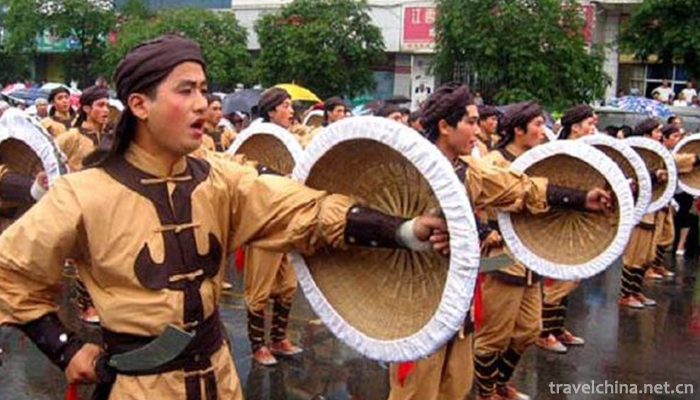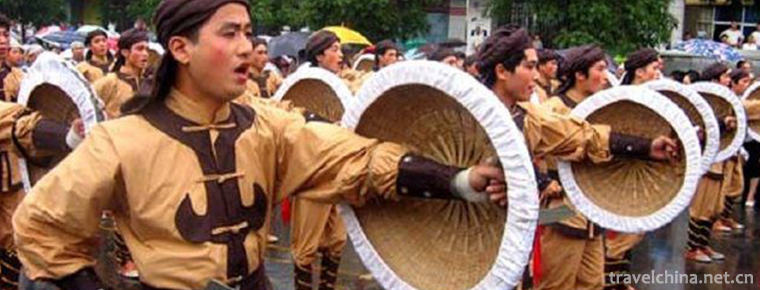Yongxin Shield Dance
Yongxin Shield Dance
Yongxin Shield Dance, a traditional folk dance in Yongxin County, Jiangxi Province, is one of the national intangible cultural heritage.
Shield dance, also known as men's group dance rattan dance, roll the shield, reflects the most primitive national cohesion, team spirit and fighting spirit. Shield dance is mainly spread in Longyuankou, Yange and other southern villages in Yongxin, Jiangxi Province. It integrates martial arts, acrobatics, dance and music. It is rough, vigorous and intrepid. The formation changes singularly and magnificently. It has strong traditional cultural characteristics and great fighting momentum.
On May 20, 2006, Yongxin Shield Dance was approved by the State Council and listed in the first batch of national intangible cultural heritage list, heritage number: III-10.
historical origin
Yongxin shield dance originated from the shield tactics of the ancient army. According to legend, the "Fujie General Talk" in Qi Jiguang's Jixian New Book, a famous anti-Japanese General of the Ming Dynasty, should be its source. There is no final conclusion as to when it was introduced into Jiangxi. One is that it was introduced when the inhabitants of the Yellow River basin moved southward on a large scale in the Qin Dynasty; the other is that it came from "Tuanpaiwu" created by Huang Gai, a famous general of the Three Kingdoms Period; the other is that shield dance originated in the Qing Dynasty, after the failure of the Taiping Heavenly Kingdom Movement at that time. The Taiping Army officers and soldiers who were exiled here were trained to make a strong resistance. Later, it was refined and perfected by some local martial worshippers, and gradually evolved into a traditional folk dance with both ornamental value and fitness and entertainment.
Dance features
Performing Form
Shield dance has a traditional, solemn and solemn performance form. The style of shield dance is characterized by small movement range and fast frequency. When performing, one should master the eight-character formula of "push, block, build, stand, push, flash, fall and roll". Before practicing, there is a solemn ceremony. The dancer should kill the cock and sacrifice the ancestral tablet under the leadership of the patriarch. Its purpose is to "pray for the gods to protect the men", which is obviously an ancient man. The legacy of the sacrificial rites before the military expedition.
Clothing characteristics
Nine warriors wore long scarves with black bottoms and white breast clouds. They wore black tights, leggings and Jute Straw shoes. One holds a steel fork with a ring, acting as a general or an enemy cavalry; the other holds a shield, a knife, and one by one is strong and powerful.
distinguishing features of music
Shield dance music is unique. Folk percussion accompaniment is often used in performances. The drum point of "turning chicken feathers" is often used around the venue. In some places, the accompaniment instrument will add strings and wind music. In some places, a traditional folk special instrument "sonar" is added. Its voice is sharp, high and very penetrating. On the basis of percussion music, shield dance music absorbs Suona Opera "gong tune" in "lantern color" and "south road scatterboard" in "long tone plus flower" in "opera" and "fast board Gong and drum in"national art", and so on. With the development of the plot, such as storms and rains, ten thousand horses galloping; such as Liri and wind, Xinma from Xinjiang; such as small bridges flowing water, etc. Ying Geyan Dance, together with the clanking ring of short knives and the "hoo" cry of actors during the performance, has played a very good role in creating a lively atmosphere.
The plot content
The plot of shield dance is relatively simple. The main performance is that the two armies break through the battlefield and attack and defend each other, but the battlefield is unpredictable. The whole performance is divided into eight formations, namely, quadrangular array, long snake array, eight-character array, wasp array, gantry array, purse array, flower array and receipt. At the beginning of the performance, the warriors fought bravely with their forks and made a left-handed and right-handed dash. Then the battle changed into a long serpentine battle, with the two armies confronting each other, and the warriors shouting at the urgent drums. After a period of walking, it suddenly changed into an octagonal array. In a rush of drums, eight warriors rolled side by side, like a wasp coming out of a hole and sweeping in. Next came the "pocket arrays" and "dragon gate arrays" surrounded and counter-surrounded. The most brilliant thing is "playing cards". The warriors relied on their daily hard-working martial arts. The real knives and forks played dazzling "jumping cards", "pulling cards", "trench cards", "rubber cards", "rolling cards" and "hiding cards".
Inheritance and Protection
Inheritance value
Shield dance is well known in Yongxin area. There was a saying that "no shield is not a man", especially when the Lantern Festival "lights out". It is deeply loved by local people and enriches people's cultural life. New Shield Dance is a microcosm of folk customs in mountainous areas of Southwest Jiangxi Province. It embodies the most primitive national cohesion, team spirit and fighting spirit. As far as artistic value is concerned, it integrates martial arts, juggling, dancing and sculpting, and becomes a typical representative of local culture.
Current situation of inheritance
Shield dance, as a very distinctive traditional dance art, is widely welcomed by the people. In contemporary times, it has become a perfect form of fitness and entertainment for farmers in Yongxin and even in Jinggangshan, Taihe and surrounding counties and cities. It has become a "reserved program" to celebrate rural marriages and children's entrance to school. With the rapid development of cultural life and the successive death of old artists, shield dancing is in danger of losing its heritage, so rescue work is imminent.
Heritage figures
Wu Sangui, male, Han nationality, born in 1948 in Nantang Village, Longyuankou Town, Yongxin County, Jiangxi Province. In February 2008, Wu Sangui was selected as the representative successor of the second batch of national intangible cultural heritage projects and declared in Yongxin County, Jiangxi Province.
protective measures
Yongxin County has invested a lot of manpower, material and financial resources, established special research institutes, trained professional teams, launched a series of activities, and made every effort to excavate and organize shield dance.
On May 20, 2006, Yongxin Shield Dance was approved by the State Council and listed in the first batch of national intangible cultural heritage list.
Shanghai Science and Technology Film Studio will record Yongxin Shield Dance twice. Central News Film Studio and Pearl River Film Studio will put Yongxin Shield Dance on the screen and publicize it widely to the society.
social influence
Important Exhibitions
In 1975, more than a dozen folk artists in Nantang Village performed Shield Dance at the first folk art show in Jiangxi Province.
In the winter of 1975, "Shield Dance" was processed in Beijing and performed abroad with the former Northeast Military Region Song and Dance Troupe in the former Soviet Union, Korea and other countries.
In 1984, shield dance was selected as one of the traditional folk dance collections by Jiangxi TV station and went on the screen.
In 2005, Yongxin Shield Dance participated in the street-stepping performance of the Nanchang International Nuo Culture and Art Festival and the folk art festival performance of Jiangxi Province. As the only folk art program selected by Jiangxi Province, Yongxin Shield Dance went to Shanwei City of Guangdong Province to participate in the first Pan-Pearl River Delta "9+2" folk art performance contest, and was well received.
Honorary recognition
In 1975, shield dancing won excellent program awards and performance awards in the "National Folk Music and Dance Festival" and "Zhongnanhai Melody" held in Beijing.


-
1.Kung Pao Chicken
Kung pao chicken is a famous traditional Chinese and western famous dish
Time 2018-10-12 -
2.Fish Ball
Fish balls, also known as "fish wrapped meat", are mixed up with eel, shark or freshwater fish, mixed with sweet potato starch (* starch), and then wrapped
Time 2018-11-02 -
3.Shanghai Ocean Aquarium
Shanghai marine aquarium is located at 1388 Lujiazui Ring Road, Pudong New Area, Shanghai, China, next to the Oriental Pearl Tower. Singaporean Xingya Group and Chinese Poly Group have jointly
Time 2018-12-19 -
4.Luonan Jing Blackboard
In 2011, Luonan Jingbanshu was approved by the State Council and listed in the third batch of national intangible cultural heritage list. As early as in the Daoguang period of the Qing Dynasty (around
Time 2019-05-15 -
5.Puppet Show
Chinese puppet show has a long history. The common view is that it originated in the Han Dynasty and flourished in the Tang Dynasty. In the Three Kingdoms, couples could perform acrobatics, while in t
Time 2019-06-06 -
6.Baisha Xile of Naxi Nationality
Naxi Baisha Xile is also known as "Xiaoli at breaking time", "Xiaoli at breaking time", "Xili at breaking time", "Xili at breaking time" and "Xie Li at bre
Time 2019-06-06 -
7.Nanping Opera
Nanping Opera is a folk art popular in the area of Jiuzhaigou County (former Nanping County) on the Northwest Plateau of Sichuan Province. It was once called "Nanping Pipa Playing and Singing&quo
Time 2019-06-07 -
8.Four strands
Four-strand string, also known as four-strand string, two-strand string, five-tune string and five-tune tune tune tune, is one of the ancient traditional local operas in China. It originates from Julu
Time 2019-06-16 -
9.Ying Luohan
Yingluohan is a form of traditional folk entertainment which integrates martial arts and folklore in the traditional festival activities in Jinyun County, Zhejiang Province. This kind of activity also
Time 2019-07-14 -
10.Make a chant
Bamboo and hemp trumpet is a traditional folk song of Qionglai City, Sichuan Province. It belongs to a kind of labor trumpet sung by local papermaking workers when playing bamboo and hemp. It is mainl
Time 2019-08-03 -
11.Cultural undertakings in Luzhou
By the end of 2017, Luzhou had 8 cultural centers and 142 cultural stations, including 128 Township comprehensive cultural stations, 14 urban community (street) cultural centers, 9 public libraries, 2 art galleries and 13 museums (memorial halls), all of which are free of charge.
Time 2020-12-14 -
12.Mianyang tertiary industry
In 2019, the added value of the tertiary industry in Mianyang will increase by 9.4%, 0.9 percentage points higher than the average level of the whole province. Among them, the added value of wholesale and retail industry increased by 9.5%, transportation
Time 2020-12-14